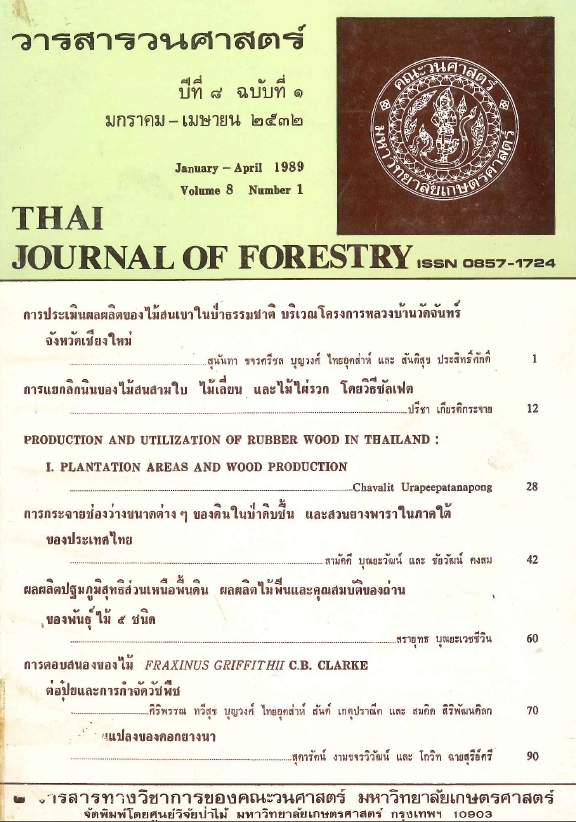การแยกลิกนินของไม้สนสามใบ ไม้เลี่ยน และไม้ไผ่รวก โดยวิธีซัลเฟต
Main Article Content
บทคัดย่อ
การวิเคราะห์ผลผลิตเยื่อ ตัวเลขคัปปา และปริมาณลิกนินในเยื่อซัลเฟตจากไม้ไผ่รวก ไม้เลี่ยน และไม้สนสามใบ โดยต้มเยื่อที่ active alkali 16% sulfidity 25% สัดส่วนของน้ำยาต้มเยื่อต่อชิ้นไม้สับเป็น ๔ : ๑ และอุณหภูมิสูงสุดระหว่าง ๑๒๐° ถึง ๑๘๐° ซ. โดยกำหนดค่า H-factor ตั้งแต่ ๒ ถึง ๑,๒๖๑ พบว่าไม้ไผ่รวกแยกเยื่อและลิกนินได้เร็วที่สุด ส่วนไม้สนสามใบช้าที่สุด จากการใช้สมการการทดสอบแบบดอก วิเคราะห์หาความสัมพันธ์ระหว่าง H-factor กับตัวเลขคัปปา และ H-factor กับปริมาณลิกนินพบว่า กำลังสองของค่าสัมประสิทธิ์ของการทดลองจากเยื่อไม้ไผ่รวกและไม้เลี่ยน มีค่าสูงกว่า ๐.๘ ส่วนเยื่อไม้สนสามใบช้าที่สุด ความสัมพันธ์ระหว่างตัวเลขคัปปา และปริมาณลิกนินของเยื่อทั้ง ๓ ชนิด เป็นสมการทดลองแบบเส้น ซึ่งมีค่ากำลังสองของประสิทธิ์ของการทดสอบประมาณ ๐.๘
Downloads
Article Details

อนุญาตภายใต้เงื่อนไข Creative Commons Attribution-NonCommercial-NoDerivatives 4.0 International License.
ข้าพเจ้าและผู้เขียนร่วม (ถ้ามี) ขอรับรองว่า ต้นฉบับที่เสนอมานี้ยังไม่เคยได้รับการตีพิมพ์และไม่ได้อยู่ในระหว่างกระบวนการพิจารณาตีพิมพ์ลงในวารสารหรือสิ่งตีพิมพ์อื่นใด ข้าพเจ้าและผู้เขียนร่วม (ถ้ามี) ยอมรับหลักเกณฑ์และเงื่อนไขการพิจารณาต้นฉบับ ทั้งยินยอมให้กองบรรณาธิการมีสิทธิ์พิจารณาและตรวจแก้ต้นฉบับได้ตามที่เห็นสมควร พร้อมนี้ขอมอบลิขสิทธิ์ผลงานที่ได้รับการตีพิมพ์ให้แก่วารสารวนศาสตร์ คณะวนศาสตร์ มหาวิทยาลัยเกษตรศาสตร์ กรณีมีการฟ้องร้องเรื่องการละเมิดลิขสิทธิ์เกี่ยวกับภาพ กราฟ ข้อความส่วนใดส่วนหนึ่ง หรือ ข้อคิดเห็นที่ปรากฏในผลงาน ให้เป็นความรับผิดชอบของข้าพเจ้าและผู้เขียนร่วม (ถ้ามี) แต่เพียงฝ่ายเดียว และหากข้าพเจ้าและผู้เขียนร่วม (ถ้ามี) ประสงค์ถอนบทความในระหว่างกระบวนการพิจารณาของทางวารสาร ข้าพเจ้าและผู้เขียนร่วม (ถ้ามี) ยินดีรับผิดชอบค่าใช้จ่ายทั้งหมดที่เกิดขึ้นในกระบวนการพิจารณาบทความนั้น”


